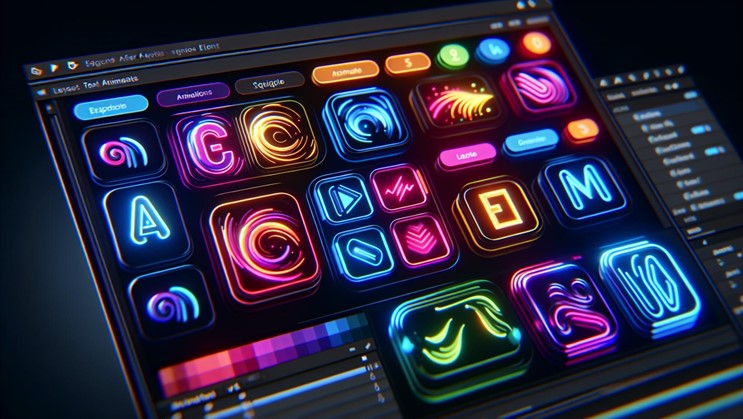Conquer the art of ‘after effects animate text’ to capture your audience’s attention instantly. Quick to learn for even the novice animator, After Effects provides a comprehensive set of tools to animate text layers, from bouncing captions to swirling titles. Dive into practical steps and insider tips that will elevate your text animations to professional levels. Prepare to animate text with finesse and tailor your animations with custom presets and expressions—all explained in this article.
Mastering Text Animation in After Effects

Text animation has become a powerful storytelling element and is no longer just a fancy add-on in digital content. From engaging social media posts to dynamic website banners, text animation adds an extra layer of interactivity that grabs attention and communicates more effectively.
The foundation of any text animation is the text layer. From adding a simple title or creating an intricate kinetic typography sequence, it all begins with a text layer. You can create one by clicking on Layer > New > Text from the top menu or using the ‘T’ button in the toolbar. Once your text layer is in place, you can start typing your content and animate.
Getting Started with Text Layers
Creating a text layer in After Effects is just the beginning of your animation journey. As previously mentioned, once you’ve typed your text, it’s time to animate! You can manipulate your text layer in a myriad of ways to create all sorts of cool animated effects. By tweaking the font properties in the Expression Language menu and moving the layer using the Timeline panel or rulers and guides, you open a whole new world of animation possibilities.
What's more, After Effects allows you to import text from other applications, making it easier than ever to start animating. You can also work with editable live text template compositions that can be manipulated in Premiere Pro for animation, giving you more flexibility and control over your projects.
However, remember that with great power comes great responsibility. Text layers in After Effects can sometimes be tricky, and you might face issues like the Paste command not working, the text layer being slow, and codec-related crashes. But don’t fret, a quick restart or a check on your composition settings usually does the trick.
Transform Properties for Simple Animations
Now that you’ve got a handle on text layers, it’s time to get those characters moving! In After Effects, you can use transform properties to animate your text. These properties include:
-
Position
-
Rotation
-
Opacity
-
Anchor point
Want your text to slide in from the side? Play around with the position property, including the Y position value. Need your words to spin into the frame? Try adjusting the rotation. The possibilities are endless!
But let’s not stop there. To make your text animations even more dynamic, you can:
-
Resize your text using the Scale property
-
Create a fade-in or fade-out effect by adjusting the opacity value over time using keyframes
-
Animate the rotation of your text to create dynamic animated titles for your projects
-
Combine these techniques to create a stunning effect where your text moves and fades at the same time.
Exploring Text Animation Presets

So, you’ve mastered the basics of text animation and are ready to take things to the next level. You can enter text animation presets to enhance your presentation. This feature allows you to add engaging visual effects to your text. Think of these as ready-to-use animations that you can apply to your text layers.
To browse through the available text animation presets, simply open the Effects & Presets panel in After Effects or use Adobe Bridge. Once you’ve found a preset you like, applying it to your text layer is as easy as a few clicks. And the best part? There are so many effects text animation presets to choose from! With Cyberpunk Text Animations to Stretch Animation Presets, there’s a preset for every project and style.
Browsing and Applying Presets
You can find text animation presets in your library such as:
-
Cyberpunk Text Animations
-
Stretch Animation Presets
-
Flipboard Text Presets
-
and so much more
You can preview these presets before applying them to your text layers, ensuring they’re a perfect fit for your project.
Applying a preset to your text layer is simple. Here’s how:
-
Create a new composition.
-
Open the Animation Presets window.
-
Pick the preset you want.
-
Apply it to your text layer.
Keep in mind that when a preset is applied to a text layer, it creates a new text layer with all the font and character properties of the preset. Now, you’re ready to start animating!
Customising Presets for Your Project
To make your text animation truly unique, you can customise the preset to suit your project’s needs and style. After Effects allows you to tweak various aspects of the presets, such as colours, position, and scale. This means that you can match the animation to your project’s colour palette, position it exactly where you want it, and adjust the scale to fit perfectly.
So, how do you go about customising these presets? Simply follow these steps:
-
Select the text layers.
-
Double-click the effect or animation preset to open its parameters.
-
From there, you can tweak the settings to match the look and feel you’re going for.
-
If you want to revisit some of your favourite presets, you can quickly apply them to your text layers by selecting the layers and choosing Animation > Recent Animation Presets.
Creating Custom Text Animations with Text Animators

Now it’s time to explore text animators. After Effects text animators enable you to manipulate character position, rotation, and size-related properties. These animations are based on the anchor point. By exploring different text properties and playing around with text animators, you can create cool and dynamic text animations.
With text animators, You choose which property to animate, add an animator group to your text layer, and control how each character or word in your text layer animates. And that’s not all. To add a selector in After Effects text animators, simply select an animator group in the Timeline panel and choose Selector from the Add menu. Selectors allow you to isolate a specific area of text to apply animated properties, giving you a level of detail and precision in your animations.
Adding an Animator and Using Selectors
To add an animator to your text layer, pick the text layer in the Timeline panel, then go to Animation > Animate Text and select a property to animate. This opens up the possibilities for creating different positions and states for your text without using standard keyframes.
But how do you target specific parts of the text to animate? This is where selectors come in. Selectors in After Effects are tools that help you focus on specific parts of the text so you can add cool animation effects to them. They’re essential because they allow you to target individual letters or parts of the text for animation, adding a level of detail and precision to your work.
To animate text along a path, you can:
-
Add selectors in the Composition panel.
-
Select a range of characters.
-
Right-click (Windows) or Control-click.
-
Adjust parameters like Start, End, and Offset to target specific characters or words.
Advanced text animator properties
Just when you thought text animators couldn’t get any cooler, we introduce you to advanced text animator properties. These properties give you even more customisation options, allowing you to create more complex and engaging animations.
With these properties, you can animate the position, rotation, and size of characters in your text layer in relation to an anchor point. Want your text to look like it’s being typed out? Try using the character offset property to animate the Unicode values of the selected characters. You can also use the shape property to animate character position, rotation, and size-related properties in relation to an anchor point.
Text Animation Techniques for Various Styles

Text animation is not a one-size-fits-all kind of thing. There are various text animation techniques you can explore to match different styles and project requirements. Whether it’s kinetic typography, 3D text animations, or animating text along a path, there’s a technique for every creative vision.
There are several different techniques for animating text, including:
-
Kinetic typography: This involves animating text to create dynamic and impactful typography animations. It is often used for title sequences or lyric videos.
-
3D text animations: This technique adds depth and dimension to your text, making it appear as if it is popping out of the screen.
-
Text animation along a path: This technique involves animating text to follow a specific path, which can be used to guide the viewer’s attention in a certain direction.
Each of these techniques can be used to create engaging and visually appealing text animations.
Kinetic Typography
Kinetic typography is a technique that animates text in a way that expresses the meaning of the words. It’s an effective way to engage viewers and convey your message in a visually appealing manner. But how do you create kinetic typography in After Effects? The process involves using the animation menu to animate your text and create different positions and states for your text without using standard keyframes.
There are several techniques for creating kinetic typography, including:
-
Smooth Text
-
Animated Backgrounds
-
Text on Path
-
Text Reveal
By integrating motion graphics, playing with timing, and syncing typography with audio, motion designers can create animations that truly pop.
3D Text Animations
3D text animations are a step up from regular text animations. They can add a touch of realism and depth to your projects, making your text stand out from the flat background. Creating 3D text animations involves making a text layer 3D and using different software tools to animate the text.
When it comes to 3D text animations, per-character 3D properties are important. These properties allow you to animate each character individually, giving you precise control over your animation. For those who want to take their 3D text animations to the next level, techniques like using cinematography skills, advanced Cinema 4D features, and mastering certain methods can help create high-quality animations without needing extra plugins.
Animating Text Along a Path
Animating text along a path is a unique way to animate your text. It’s like guiding your text along a predetermined route and watching it follow the path. This technique can be used to guide a viewer’s attention, create interesting shapes with text, or even mimic the movement of objects in a video.
To animate text along a path, you first need to create a text layer and draw a path for the text to move along. Once you’ve done that, you can adjust the text settings and animate the text along the path. By using the First and Last Margin to move the text along the path, and creating dynamic animations by drawing intricate paths, adjusting text settings, and utilising features like ‘Create Nulls From Paths’ to animate vector paths.
Enhancing Your Text Animations with Expressions

With expressions, you can add more control and complexity to your animations.
Expressions in Adobe After Effects can be used to:
-
Control and animate text properties
-
Automate tasks and control values
-
Make animations more dynamic and interactive
-
Animate properties like opacity, scale, position, and rotation
-
Create repetitive animations
-
Make animations respond to user interactions
Expression Selector Properties
When working with expressions, it’s important to understand expression selector properties. These properties control how much a property affects the characters in a text animation, providing a way to manage the impact of animation properties on each individual character in a string of text.
In After Effects, there are several types of selectors you can use, including the default range selector, Wiggly, Expression selectors, and the range selector. By using these selectors, you can create more advanced animations such as text typing or scrolling effects. You can save these expressions as animation presets to use in future projects.
Adding Expressions to Text Animators
Adding expressions to text animators can make your animations more dynamic and responsive. To add an expression to a text animator, you simply alt/opt-click the stopwatch next to the property you want to animate. This allows you to write or paste in expressions that can automate and enhance your text animations.
Expressions can give you more control and flexibility than regular keyframe animation, allowing you to create better animations that can adapt to changes and user interactions. By adding expressions to text animators, you can take control of your animations and create something truly unique.
Tips and Tricks for Polishing Your Text Animations
Now that you’ve learned the basics of text animation and explored various techniques, let’s talk about refining your work. Polishing your text animations can make them more professional and visually appealing. It’s all about paying attention to the details and fine-tuning your work.
Getting the timing and transitions right is a crucial part of polishing your text animations. By adjusting the timing of your animations and finessing the transitions, you can make your animations flow more smoothly and create a better viewing experience. But that’s not all! You can also integrate your text animations with:
-
Videos
-
Images
-
Graphics
-
Music
-
Sound effects
This will create a more cohesive and engaging piece with the same value.
Fine-tuning Timing and Transitions
When it comes to fine-tuning your animations, timing is everything. By tweaking the Ease High and/or Ease Low values, you can create smoother animations and control the pace of your text animations. And don’t forget about transitions! Smooth transitions can make your animations more professional and visually appealing. In After Effects, you can use transitions like:
-
Blurry Fade On
-
Animare in From Below
-
Tracking and Opacity
-
Type On
-
Animate Along a Path
For more guidance, you can explore various effects tutorials available online.
To make your text animations pop, consider using an 'animate' menu for added flair.
But how do you ensure your transitions look good? The key is to carefully time your keyframes for smooth movements, apply motion blur, and ensure element alignment. By paying attention to these details, you can create seamless transitions and improve the overall quality of your text animations.
Integrating text animations with video and other elements
Integrating text animations with video and other elements can take your animations to the next level. By syncing your animations with sound and using techniques like rotoscoping and facial tracking, you can create an immersive viewing experience. But how can you ensure your text animations flow smoothly with your video content? Here are some tips:
-
Keep the visual style consistent throughout your video.
-
Create seamless transitions between your text animations and video clips.
-
Match the timing and pacing of your text animations with the video.
-
Maintain a cohesive narrative that ties your text animations and video together.
By following these tips, you can create text animations that enhance your video content and engage your audience.
To sync your text animations with video frames, you can add an animator group to a text layer and select the appropriate property from the Animation > Animate Text menu or use text animator effects to finesse your synchronisation. When you’re combining text animations with images and icons, remember to use transparent shapes, transform objects together, apply both static and animated icons, and animate text and visuals to highlight important elements. It’s all about creating a cohesive and engaging piece.
Join Us at Nexacu
Ready to elevate your digital content and dazzle your audience with captivating text animations? Join us at Nexacu, where we turn your creativity into mastery with our comprehensive After Effects courses. Whether you aspire to craft mesmerising title sequences or create kinetic typography that dances to the rhythm of your message, our expert instructors are here to guide you every step of the way.
Don't just play in the world of text animation—dominate it with the skills you'll acquire at Nexacu. Enrol today and start your journey to becoming an After Effects wizard!
Frequently Asked Questions
How do I change all the text in After Effects?
You can change all text in After Effects by navigating to the "File" menu, selecting "Scripts," and clicking on "Find and Replace." Then, you can enter the text you want to find and the replacement text. Hope this helps!
How do you animate text alignment in After Effects?
To animate text alignment in After Effects, open the text layer, set a keyframe for the alignment, and then adjust the alignment at different points in the timeline to create the animation. Easy peasy!
How do you move text in After Effects?
To move text in After Effects, simply click on the Selection tool in the Tool panel and drag the text to the desired position. Easy!
How do you add animation to text?
To add animation to text, select the text you want to animate, then choose an animation and effect options.
Can you animate text tracking in After Effects?
Yes, you can animate text tracking in After Effects by using the Tracking and Line Anchor animator properties to move all but one or a few characters.

 Australia
Australia New Zealand
New Zealand
 Singapore
Singapore
 Malaysia
Malaysia
 Philippines
Philippines
 Thailand
Thailand
 Indonesia
Indonesia























